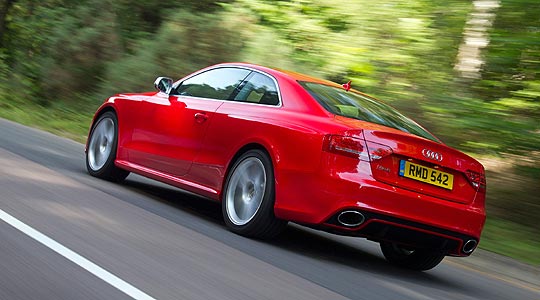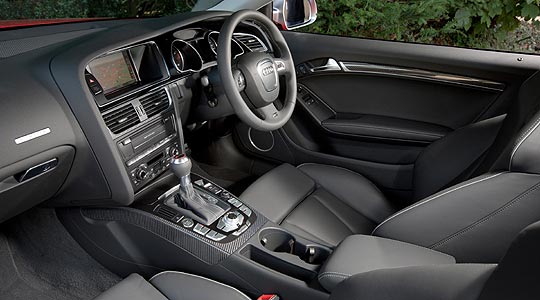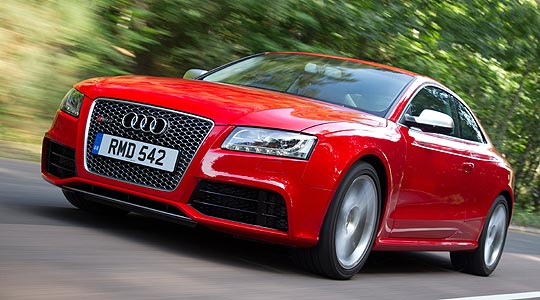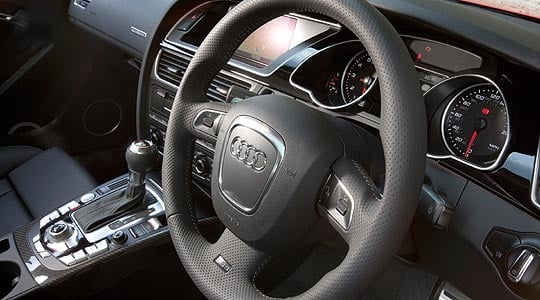
Maybe you have already read reviews of Audi’s latest road-scorcher, the RS5. If you have, they were most likely based on the car’s international launch in Spain. Now it has come to the UK, with our own brand of challenging road surfaces to tackle, so it’s time for another look.
The RS5 is certainly a tempting-sounding package. Based on the already rapid S5, it has a wholly different take on the V8 engine idea with 450bhp on offer from its 4163cc. It reaches that power at 8250rpm, it has no forced induction and it sends its power to all four wheels (obviously – it’s a quattro) via a seven-speed double-clutch gearbox. This is the same engine as you’ll find in an R8.
The four-wheel-drive system favours the rear wheels, slightly, unless something happens to change that. There’s an ‘active’ rear differential, ‘dynamic’ steering which varies the gearing according to speed, and the bodywork is muscled-up compared with the regular A5 coupé, with stretched-out wheelarches and racier valances. It costs from £58,685.
What the RS5 seems to be, then, is a direct rival for a BMW M3, which also has a high-revving 420bhp V8, a double-clutch gearbox (optional in this case), svelte two-door coupé bodywork and a £53,275 price. The RS5 is a hardcore sporting Audi and, if it’s anything like as entertaining as the old RS4, whose diagonally interconnected, roll-reducing suspension cleverness it shares, as well as the spirit of its madly-revving V8, it should be love at first B-road.

To uncover the RS5’s character, though, calls for a thorough exploration of its Drive Select system. As it does in other high-end Audis, this offers Comfort, Auto and Dynamic modes which apply across the whole gamut of engine response, suspension firmness, steering weight, gearbox responsiveness, the degree to which the electronically regulated rear differential allows amusing oversteer moments and the extent to which the ESP system stands back and watches. Or, crucially, you can tailor each setting individually to make any combination you favour.
This explains why men in Audi uniforms have been doing things to the car I’m about to drive before I get to sit in it. They have been setting all controls back to default, and as I drive off I find it’s in Comfort. It still seems quite fidgety but the roads in south Buckinghamshire, where the drive event is based, are especially badly maintained.

There’s a powerful-sounding V8 up front, but its voice is muted. The whole car feels quite stodgy and cumbersome, and not the lithe powerhouse I had expected. Let’s select Dynamic. Good grief! Now the RS5 hurtles forward, or at least it does provided I have at least 3000rpm showing (it’s a bit sleepy below those revs), and as it does so it emits a delicious crackling bellow punctuated by impressive bass-laced sputters with each gearchange. This is fun.
The ride isn’t, though. The suspension seems to have solidified, causing every one of the myriad bumps and holes and cracks and coarsenesses to come straight into the cabin. Clearly, Dynamic suspension is for smooth racetracks only; I’m on the M40 now and even the motorway is making the RS5 jerk and check constantly.

A few miles later, I’m out of the congested edges of the London-centred sprawl and onto some proper country roads, some fast and open, some tight and twisty. Here, if the RS5 is anything like the old RS4, is where the new coupé should be very entertaining. So it proves, if there’s a car to pass, but only because of the sound and the high-revs acceleration. From a standstill to that metrically enforced benchmark of 62mph is claimed to take just 4.6 seconds, while – for a fee – the normal top speed of 155mph can be upped to 174mph after an electronic tweak.
As for the way the RS5 copes with the bends and the bumps, I’m afraid it’s not very good. On a track it surely is, but on the road, and despite the quattro system’s best efforts, it just feels wooden with blunt, unresponsive steering which ensures that the RS5 never loses that unwieldy, cumbersome feel I noticed at the start. The Sport setting just makes the steering heavier without adding proper road feel, but in Comfort or Auto it feels oddly disconnected from the RS5’s high-force kinetics. The seven-speed gearbox adds further to the sense of a video game. I’d much rather have the RS4’s manual shift.
This is disappointing. All that pace, but little pleasure from using it. The key problem with the RS5, in fact, is that its suspension is far too firm so it never has a chance to breathe and flow with the road, to give you the feeling it’s following the landscape instead of beating it into submission. Dynamic mode is unusable for the suspension, Auto isn’t much better. The only way to make the RS5 tolerable, and to get the best out of its good points, is to set the suspension to Comfort and everything else to Dynamic, and even then the RS5 is too tightly damped, forever fidgeting and fractious.

So the fact that this is a very well-finished, fine-sounding and extremely fast coupé is largely irrelevant. It simply isn’t nice to drive, so what would you do with it? BMW’s best M3, by contrast, which is the one with the Competition Pack, steers beautifully and always feels precise, compact, wieldy and – perhaps surprisingly – compliant over bumps. Game over.
A final observation. The Audi R8 rides amazingly well for a supercar, thanks partly to its BWI Magneride adaptive dampers, and it has steering and handling to match. It’s a world away from the RS5 here. How can Quattro GmbH, creator of both cars, get one so right and the other so wrong?
Text: John Simister
Photos: Audi
ClassicInside - The Classic Driver Newsletter
Free Subscription!






